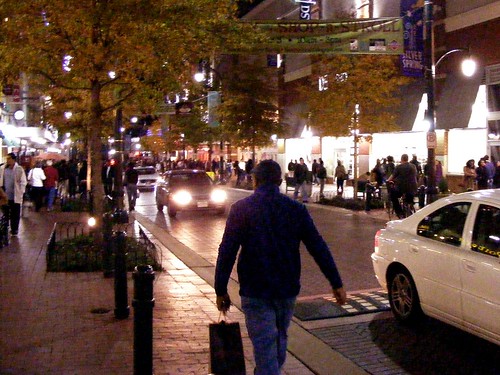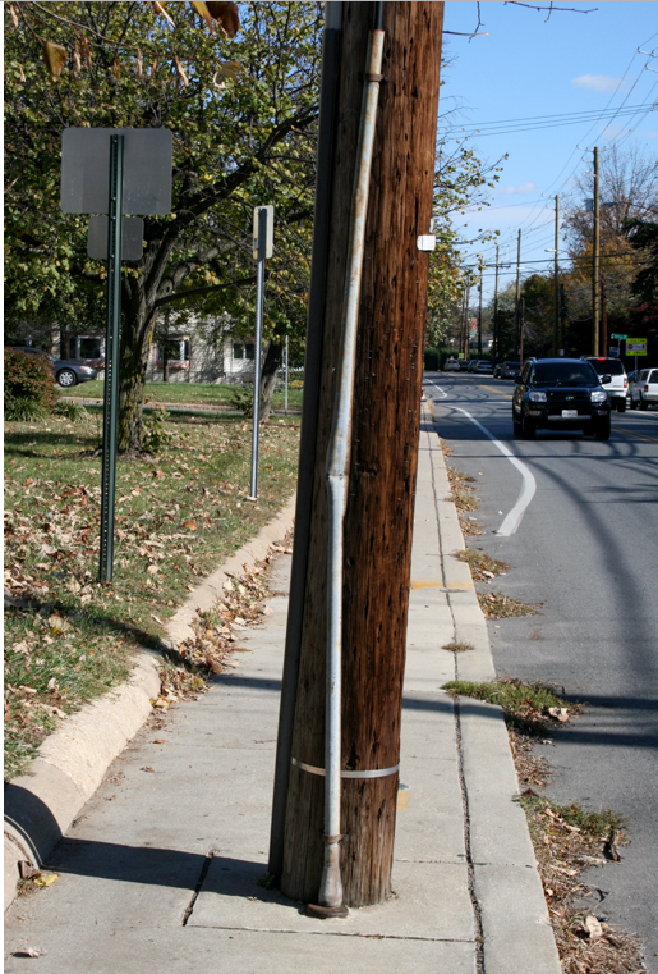The following comes to us from guest blogger Alex Hutchinson, a Takoma Park resident and intern at the Planning Department. He last wrote for JUTP about the proposed Silver Spring Library pedestrian bridge. If you have any questions or bones to pick, please contact him at alexanderehutchinson at gmail dot com.
Photo by the author.
If a car were blocking a major intersection, it would be towed within minutes. Yet this telephone pole gets a free pass despite being directly in front of the Silver Spring Police Station.
Walk around Silver Spring and you’re likely to notice the numerous light poles, parking meters, and electrical boxes inconveniently placed in the middle of sidewalks and curb ramps.
Through a comprehensive set of sidewalk and street improvements, we can restore equal access while promoting healthy walkable communities.
Planners and traffic engineers are spreading the gospel of complete streets, which provide equal access to bicycle, pedestrian, transit, or car users regardless of age or ability. Complete streets include wide sidewalks, bike lanes, frequent crossing opportunities, median islands, and more.
A few weeks ago, The Coalition for Smarter Growth hosted Ian Lockwood, a transportation expert who talked about complete streets and the communities in the United States and Canada he has helped fix. Lockwood was a consultant on the recently approved White Flint Master Plan.
One of Lockwood’s counterintuitive ideas is the concept of shared streets. Streets that seemingly lack any organization: no signs, lanes, crosswalks, speed limits, stop lights or curbs.
Lockwood doesn’t say that we should take all the street signs down. Rather, roads must be strategically redesigned for slower, but better-flowing travel. This requires a new set of cues. Raised brick crosswalks are a common shared-space method for slowing cars at intersections because they provide a visual and tactile signal for motorists to brake and watch for pedestrians. Lockwood explains that changes in textures, paving materials, trees, or colors allow streets to dictate the rules of the road better than any sign.

Silver Spring’s Ellsworth Drive is a great example of this. When the street is open to traffic on weekdays, cars move at a leisurely pace creating a safe environment for pedestrians of all types. The varying surface from brick to asphalt keeps drivers alert and aware of their surroundings.
Downtown Silver Spring has many of the critical features that Lockwood emphasizes for successful shared spaces: a good street network, buildings that hold the street, lots of pedestrians and cycling, and a vibrant environment for entertainment and social contact.” This idea of shared spaces could very well be applied to the Fenton/Wayne intersection.
Many curbs and sidewalks across Silver Spring are being repaired to better accommodate wheelchairs and pedestrians of all types. But awkwardly placed telephone poles, light posts, and even bus stops show many are still in need of work.
William Smith is a Silver Spring resident who has taken matters into his own hands. Smith, who is legally blind, is the founder of the blog Montgomery Sideways, which documents the shortcomings of Silver Spring sidewalks. Smith meticulously records and posts the locations of problem areas on Google maps in hopes that improvements can be made for the disabled. “Crossing the street in this town is downright dangerous,” he says. “The simple act of walking down the street can be an ankle-busting experience for anyone - especially a blind guy.”
The complete street approach is the most sensible and effective option for improving accessibility. By continuing to improve the sidewalks, removing thoughtlessly placed infrastructure, creating shared spaces, slowing down traffic speed and improving our public transportation we can restore equity to those who are less mobile.
It might be simple, but Silver Spring’s solution to the future is the oldest form of transportation: walking.
Crossposted at The Straight Line.
Photo by the author.
If a car were blocking a major intersection, it would be towed within minutes. Yet this telephone pole gets a free pass despite being directly in front of the Silver Spring Police Station.
Walk around Silver Spring and you’re likely to notice the numerous light poles, parking meters, and electrical boxes inconveniently placed in the middle of sidewalks and curb ramps.
Through a comprehensive set of sidewalk and street improvements, we can restore equal access while promoting healthy walkable communities.
Planners and traffic engineers are spreading the gospel of complete streets, which provide equal access to bicycle, pedestrian, transit, or car users regardless of age or ability. Complete streets include wide sidewalks, bike lanes, frequent crossing opportunities, median islands, and more.
A few weeks ago, The Coalition for Smarter Growth hosted Ian Lockwood, a transportation expert who talked about complete streets and the communities in the United States and Canada he has helped fix. Lockwood was a consultant on the recently approved White Flint Master Plan.
One of Lockwood’s counterintuitive ideas is the concept of shared streets. Streets that seemingly lack any organization: no signs, lanes, crosswalks, speed limits, stop lights or curbs.
Lockwood doesn’t say that we should take all the street signs down. Rather, roads must be strategically redesigned for slower, but better-flowing travel. This requires a new set of cues. Raised brick crosswalks are a common shared-space method for slowing cars at intersections because they provide a visual and tactile signal for motorists to brake and watch for pedestrians. Lockwood explains that changes in textures, paving materials, trees, or colors allow streets to dictate the rules of the road better than any sign.

Silver Spring’s Ellsworth Drive is a great example of this. When the street is open to traffic on weekdays, cars move at a leisurely pace creating a safe environment for pedestrians of all types. The varying surface from brick to asphalt keeps drivers alert and aware of their surroundings.
Downtown Silver Spring has many of the critical features that Lockwood emphasizes for successful shared spaces: a good street network, buildings that hold the street, lots of pedestrians and cycling, and a vibrant environment for entertainment and social contact.” This idea of shared spaces could very well be applied to the Fenton/Wayne intersection.
Many curbs and sidewalks across Silver Spring are being repaired to better accommodate wheelchairs and pedestrians of all types. But awkwardly placed telephone poles, light posts, and even bus stops show many are still in need of work.
William Smith is a Silver Spring resident who has taken matters into his own hands. Smith, who is legally blind, is the founder of the blog Montgomery Sideways, which documents the shortcomings of Silver Spring sidewalks. Smith meticulously records and posts the locations of problem areas on Google maps in hopes that improvements can be made for the disabled. “Crossing the street in this town is downright dangerous,” he says. “The simple act of walking down the street can be an ankle-busting experience for anyone - especially a blind guy.”
The complete street approach is the most sensible and effective option for improving accessibility. By continuing to improve the sidewalks, removing thoughtlessly placed infrastructure, creating shared spaces, slowing down traffic speed and improving our public transportation we can restore equity to those who are less mobile.
It might be simple, but Silver Spring’s solution to the future is the oldest form of transportation: walking.
Crossposted at The Straight Line.


8 comments:
I hope that in the updates, they consider the placement of the crosswalks. Some intersections don't have crosswalks at all four roads, requiring you to sometimes take the long way around the intersection if you want to cross legally. It'd be nice if they'd consider the direction that most people seem to need/want to cross, then make sure the crosswalks definitely go that way.
This is real access for all. Building a bridge to serve lazy motorists who don't like to walk isn't.
Long before we consider building new expensive bridges or buildings, we need to shore up our sidewalks, crosswalks and other basic needs. If being able to easily walk or use your wheelchair isn't access for all, I don't know what is.
~Patrick Thornton
I second Patricks comments. Great post BTW
For instance, Ellsworth @ Fenton should be a roundabout, no light.
I was walking in SS the other night and the flower beds on the sidewalks on Ellsworth interrupt the flow of pedestrian traffic. Why not move these on to the street to disrupt the flow of automobile traffic.
If you were in charge of the budget which intersections would you like to see fixed? Which awkward landscaping, electrical boxes, or other miscellaneous items have you noticed that are chronic congestion areas?
Yeah, MoCo just doesn't make sense sometimes. They spend all this money redoing sidewalk ramps (good), but they've redone them multiple times, apparently due to complete screwups (bad), spend money on brick pavers for most sidewalks (good), but stick telephone poles and parking meters in the middle of the sidewalks (bad).
The most egregious I find is Thayer Ave., where you have tiny sidewalks, with parking meters in the middle of them, a telephone pole entirely blocking the sidewalk at the thayer/fenton gas station, a storm drain at Thayer/Fenton that's been sticking a foot up in the air since the snow storms last year, and the dirt in the tree beds has settled, making yet another obvious tripping hazard. The street would be laughable in a 3rd world country, much less (theoretically) prime DTSS real estate.
I agree the telephone pole and meters make Thayer a bit of a maze. But, at least there is a sidewalk there. Go down Grove St. from the police station to Bonifant. First block has a sidealk halfway down one side of the street then none. The next block has a sidewalk halfway down the block. The next block there is a sidewalk on the other side of the street for a whole 5 yards. The rest of the block and the whole next block there is no sidewalk.
I semi-understand regulations about where sidewalks need to be, but this street has too many pedestrians for there not to be adequate sidewalks.
My nomination for easiest to fix but currently worst intersection is Sligo and Fenton -- every time I walk N on Fenton I have to choose between competing with Greyhound buses, taxis and drivers dropping off relatives/friends vs slurpee-jerky addicted 7-11 customers -- both sets are equally frightening and equally as oblivious to pedestrian right-of-way. Pile on top of that multiple street signs and poles blocking your sidewalk access and views of what is coming. Recipe for disaster.
Post a Comment